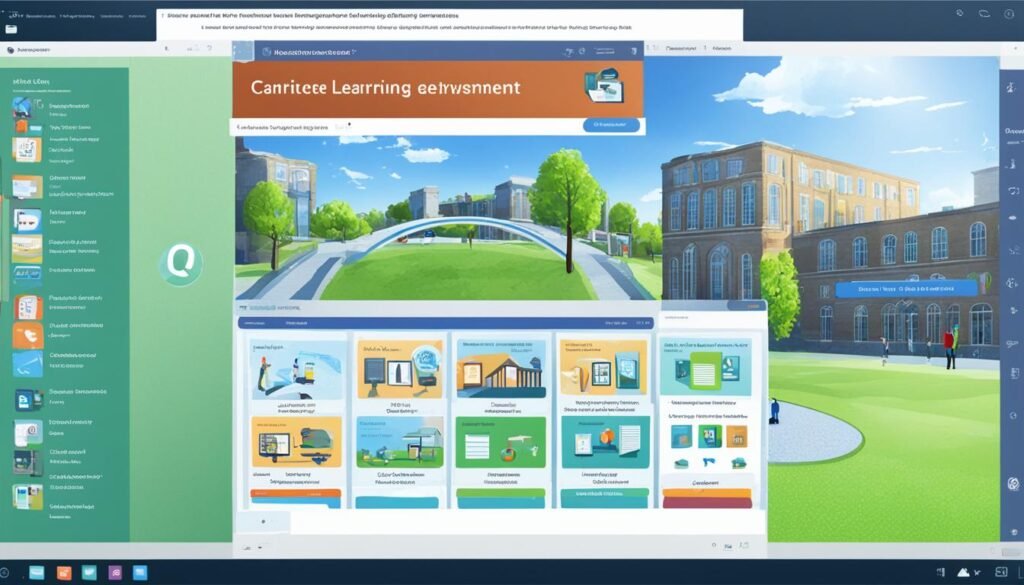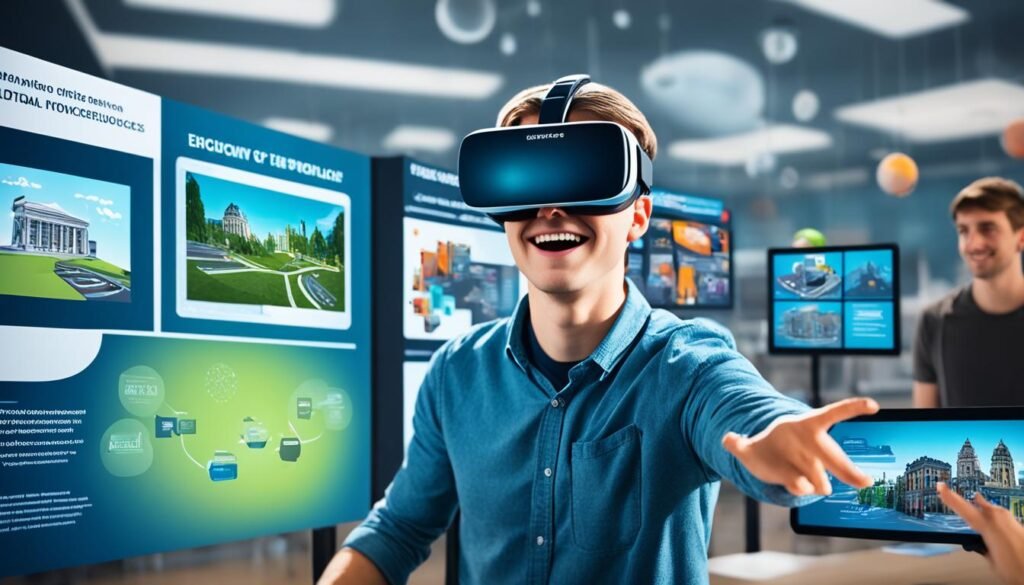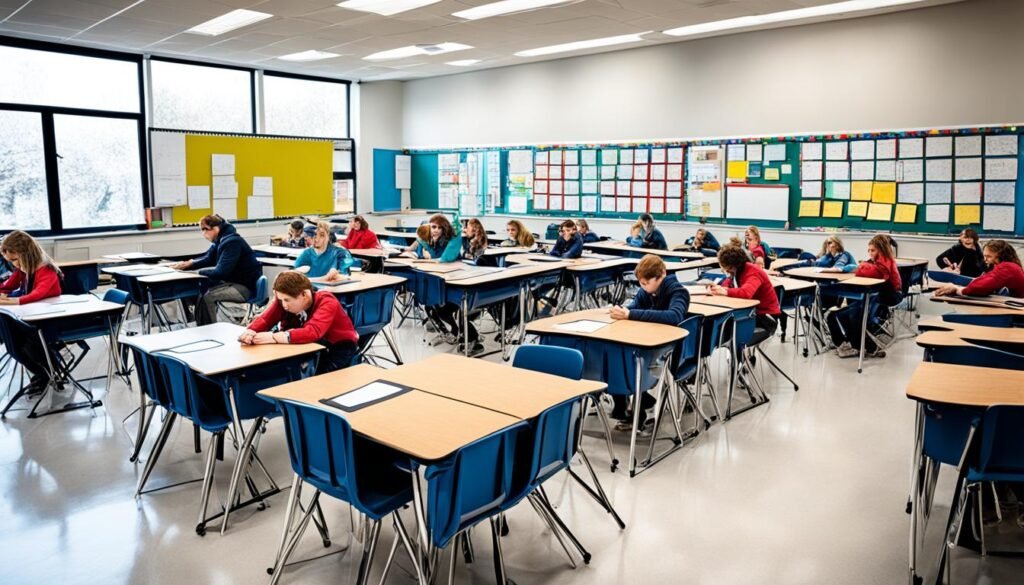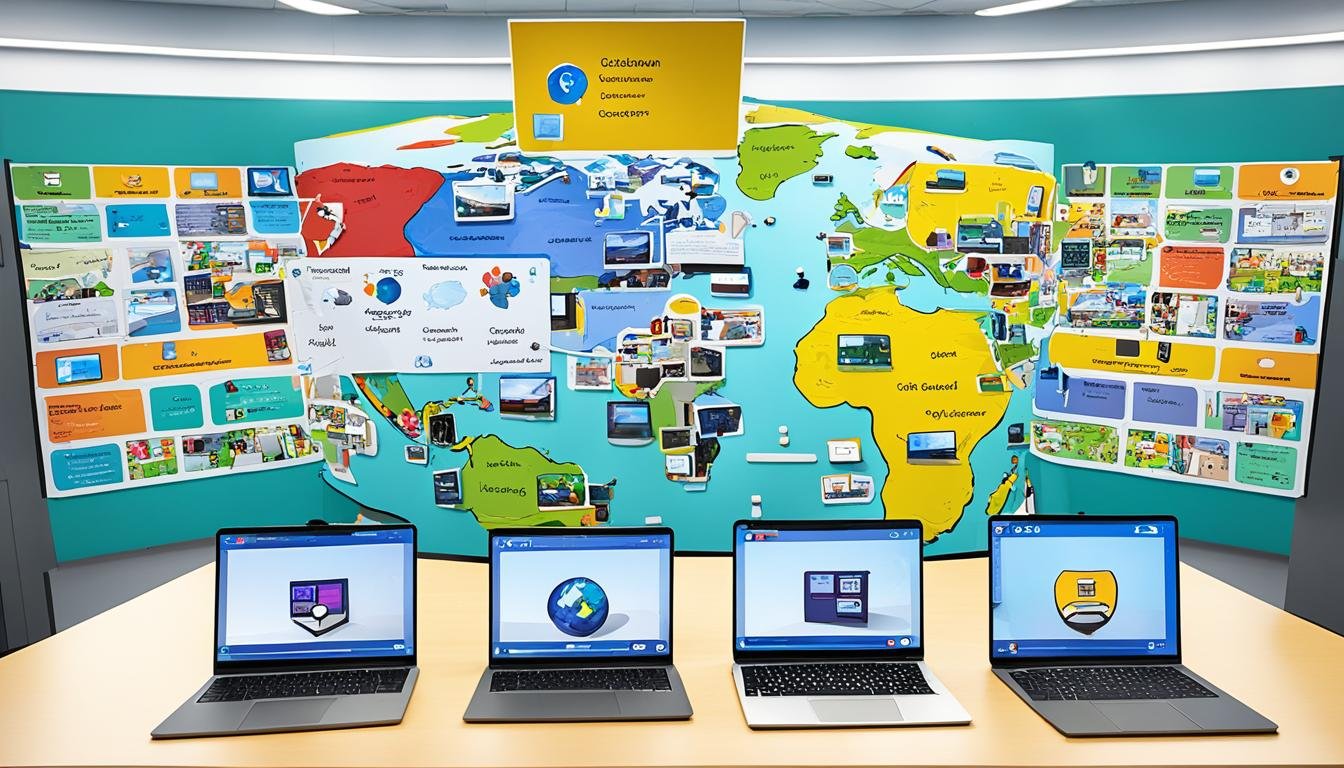Have you ever wondered how a virtual learning environment can reshape the landscape of online education? As more institutions embrace e-learning platforms, understanding what constitutes an effective VLE becomes imperative. Virtual learning environments serve as digital platforms where comprehensive educational experiences are facilitated through online technologies. These environments accommodate various learning methods, from entirely online courses to blended approaches that strategically combine traditional face-to-face instruction with digital resources.
Institutions like The Continents States University exemplify the commitment to developing robust virtual learning environments that significantly enhance accessibility to education. With the shift towards distance learning already underway before the COVID-19 pandemic, more schools have recognised the value in offering fully virtual courses tailored for students with unique needs, such as competitive athletes or those requiring flexibility due to health issues1. Moreover, research shows that 90% of students find online learning to be more effective than traditional methods2.
Key Takeaways
- Virtual learning environments provide flexible and accessible options for education.
- They can facilitate various learning styles through synchronous and asynchronous methods.
- Institutions are increasingly utilising VLEs to cater to students with specific needs.
- Effective tools enhance the virtual learning experience, improving student engagement.
- The popularity of online education continues to grow, particularly post-pandemic.
Introduction to Virtual Learning Environments
The introduction of virtual learning environments (VLEs) signifies a pivotal change in educational practices worldwide. These platforms facilitate online learning by offering interactive digital spaces where educators can create engaging content. Historical developments in educational technology have been vital in shaping VLEs, as advancements have made remote learning more accessible than ever.
In 2018, the UK House of Lords recognised the significance of VLEs in enhancing educational outcomes, noting that their adoption is essential for future pedagogical strategies3. Furthermore, educational institutions have increasingly turned to these platforms to overcome traditional limitations associated with physical classrooms4.
The shift towards online platforms has been accelerated by the growing need for accessible education, particularly during recent global events. VLEs allow for diverse learning experiences tailored to individual student needs. As more educators embrace these technologies, the potential for improving student engagement and learning outcomes expands.
The Importance of Virtual Learning Environments
Virtual Learning Environments (VLEs) hold significant importance in the realm of modern education, offering flexible pathways for learners. They effectively bridge gaps in educational access, ensuring that students from various backgrounds can partake in learning experiences that might otherwise be out of reach due to geographical, financial, or time constraints.
The continuing evolution of remote learning strategies amplifies the benefits of VLEs, especially in times of crisis. For instance, during the COVID-19 pandemic, many educational institutions relied heavily on VLEs to maintain continuity in education, showcasing their effectiveness in sustaining learning environments amid adversity. This adaptability highlights the role of VLEs in promoting inclusivity, enabling learners of different abilities and preferences to engage with educational content tailored to their needs.
Engagement is essential in the learning process, which is why VLEs incorporate diverse methodologies to cater to varied learning styles. The importance of VLEs extends to their ability to facilitate interactive learning experiences through multimedia resources, discussions, and collaborative projects. Such features not only enhance understanding but also encourage active participation from students.
Overall, the strategic implementation of VLEs contributes significantly to creating accessible educational opportunities. In this way, VLEs not only enrich the learning experience but also reshape the landscape of education, making it more inclusive and adaptable to the needs of all learners. Embracing these environments will likely pave the way for more innovative approaches in instructional design and educational delivery35.
Key Features of a Virtual Learning Environment
The key VLE features contribute significantly to the success of online education. A user-friendly interface ensures that students can navigate the platform with ease, which enhances their overall learning experience. Integration with popular online education tools, such as Google Classroom and Microsoft Teams, increases usability and appeal to educators familiar with these systems6.
Interactive learning is central to engaging students effectively. Tools like video conferencing and live chat facilitate real-time collaboration, allowing seamless communication between students and teachers, regardless of their physical locations6. Comprehensive assessment tools, including automated grading and detailed analytics, enable educators to track student progress and identify areas for improvement6.
- Discussion forums foster community and knowledge sharing among students.
- Grading systems simplify evaluation processes.
- Multimedia resources enrich lessons through varied content presentation.
Accessibility features, such as screen reader compatibility, are essential for ensuring all students can participate fully in interactive learning environments. Key characteristics of virtual classrooms include intuitive user interfaces, flexibility for anytime learning, and real-time tracking of learner progress7. These elements help create dynamic and engaging experiences that keep students motivated.

Addressing concerns over the digital divide remains crucial, particularly as not all students may have equal access to technology and reliable internet connections, which can impact their ability to use VLE features effectively6.
Benefits of Using a Virtual Learning Environment
The benefits of VLEs are extensive, catering to the diverse needs of learners and educators alike. These environments facilitate personalised learning experiences, allowing you to proceed at your own pace, which is among the key online education advantages. With VLEs, engagement is heightened through interactive tools and resources, promoting a more dynamic learning atmosphere. You may find that the availability of varied materials enhances your educational journey significantly.
Cost-effectiveness represents another compelling aspect of flexible learning. Institutions can reduce expenditures linked to physical infrastructure, while you, as a learner, benefit from decreased tuition costs. VLEs foster collaboration among peers and educators, making it easier to provide real-time feedback on assessments and group projects.
This adaptiveness is especially advantageous in remote learning scenarios, where students have access to technology that supports diverse learning styles. The capability to utilise virtual labs further aids in practical learning, enabling simulation of various experiments without the high costs associated with traditional labs8. In addition, the integration of a global array of resources enriches the VLE experience, encouraging greater exploration and knowledge acquisition.
Ultimately, the benefits of VLEs are pivotal in redefining education. They align well with current technological advancements and societal needs, ensuring a robust platform for lifelong learning9. As the education landscape continues to evolve, embracing these advantages will become increasingly crucial for achieving educational success.
Comparison with Traditional Learning Environments
In the realm of education comparison, evaluating traditional vs virtual learning environments reveals significant differences in their approaches. Traditional learning often emphasises in-person interactions, where students engage within a physical classroom setting. This dynamic facilitates a unique social environment that supports peer-to-peer relationships and enhances collaborative learning.
Conversely, virtual learning environments provide unparalleled flexibility, allowing students to manage their time and study conditions effectively. For instance, New Hampshire’s public schools, before a recent push for privatisation of education, were ranked sixth nationally, indicating a solid but rival approach to modern educational practices5. This shift towards virtual platforms empowers students to customise their learning experiences, access resources, and engage with content in innovative ways.
Additionally, while traditional settings tend to favour structured routines, virtual options encourage self-directed learning. Charter schools in New Hampshire have found they must request nearly double the per pupil adequacy grant amounts compared to traditional schools for their operations to remain viable5. This illustrates the financial dynamics at play and raises questions about the sustainability of various education models.
In conclusion, the traditional vs virtual learning analysis sheds light on not only pedagogical preferences but also resource accessibility and student engagement approaches, highlighting the distinct strengths and limitations inherent in each learning environment.
The Role of Technology in a Virtual Learning Environment
Technology is integral to the effective operation of a virtual learning environment (VLE). Adoption of VLE technology has surged, necessitating constant connectivity for online learning to facilitate access to materials and assignment submissions. Programs funded by E-Rate now allow students to check out Wi-Fi hotspots, ensuring they remain connected at home10. This shift highlights the essential role of e-learning tools in education.
Rural districts have made significant strides in integrating educational technology thanks to enhanced internet access and more affordable tech options. As educational frameworks evolve, Advanced Placement exams are transitioning to digital formats, which better secure and maximise flexibility for both students and educators. Many school districts have diversified their offerings, with thousands participating in online education programmes10.
Machine learning principles are utilised to refine teaching methods and optimise learning spaces. Such innovations enable educators to produce and distribute customised learning materials quickly, allowing for a tailored approach that addresses specific educational needs11. Furthermore, technology fosters collaboration among instructors, facilitating better communication with students, which is critical in managing remote learning environments.

Virtual Learning Environment Tools and Technologies
The successful operation of virtual learning environments (VLEs) relies heavily on various VLE tools and educational technologies. Schools must bolster network continuity as they adopt more technology to ensure constant online learning connectivity10. Key tools include Learning Management Systems (LMS), assessment software, and collaboration applications, all of which facilitate interaction and engagement among students and educators.
Utilising online learning tools effectively enhances the educational experience. For example, approximately 6,000 students attend a district’s 100% virtual school programme10. This illustrates how VLE tools can cater to a diverse range of learning needs, ensuring that all students have access to quality education.
Furthermore, resources like The Continents States University’s library of educational technologies play a vital role in supporting VLEs. As educational institutions embrace advancements, the transition to digital assessments is underway, with 28 Advanced Placement exams set to transition to digital by May 202510. This shift not only increases convenience for students but also enhances exam security.
In addition, notable educators are developing new online curricula, as seen when Blaire Penry, 2024 Washington State Teacher of the Year, created an innovative curriculum during the COVID-19 pandemic10. These efforts highlight the importance of utilising effective tools to maximise the benefits of virtual learning environments.
Designing an Effective Virtual Learning Environment
The design of a virtual learning environment plays a pivotal role in achieving effective learning environments. Incorporating user-centred design principles is essential, as this approach focuses on meeting the needs and preferences of users, ensuring that the interface is intuitive. Clear and straightforward navigation simplifies online course design, enabling learners to locate resources and materials with ease.
It is crucial to integrate varied instructional strategies to cater to diverse learning preferences. Utilising multiple formats—such as video, text, and interactive elements—can enhance engagement and accommodate different styles of learning.
Furthermore, creating a comfortable and supportive digital space encourages participation. The integration of smart technology in learning environments can enhance the overall experience, adapting to the needs of individuals in real-time.
Statistics reveal that a positive school climate can significantly boost student engagement and reduce absenteeism rates, highlighting the importance of fostering an inviting online atmosphere for learners12. Similarly, advanced systems can optimise performance metrics, improve user satisfaction, and provide essential feedback for continuous improvement in VLE design13.
Challenges in Implementing Virtual Learning Environments
Implementing a virtual learning environment (VLE) poses various challenges that educational institutions must navigate carefully. Technology-related issues often emerge as significant VLE challenges, where the integration of new systems requires robust infrastructure and reliable internet connectivity. Without addressing these implementation hurdles, the effectiveness of online learning may diminish.
Resistance to change among staff is another common barrier, as many educators may feel overwhelmed by new technologies. Training programmes need to be comprehensive, ensuring all teachers are equipped with the necessary skills to leverage VLEs effectively. Lack of training can exacerbate online learning issues, leading to frustration and disengagement.

Real-world examples illustrate how institutions addressed these VLE challenges. A detailed analysis revealed that developing a supportive culture around technology adoption can significantly improve staff buy-in4. Moreover, clear communication about the benefits of VLEs can ease implementation hurdles faced during transitions14.
Additionally, research indicates that peer support systems and collaborative training initiatives can mitigate resistance and enhance the overall experience of transitioning to a VLE3. Institutions that engage all stakeholders in discussions about new technologies often find themselves better positioned to tackle the complex nature of online learning issues.
Strategies for Success in a Virtual Learning Environment
Success in virtual learning environments requires thoughtful VLE strategies that enable both educators and learners to thrive. Critical to this process is the fostering of community among online learners, which cultivates collaboration and support.
Employing varied instructional methods is vital for successful online learning. With a mix of synchronous and asynchronous formats, you can accommodate different learning styles, promoting a more inclusive educational experience. Regular assessments of both course content and student engagement help gauge effectiveness and identify areas for improvement.
Implementing educational best practices can significantly enhance the overall learning experience. Consider the following strategies:
- Encourage interaction through discussion forums and group projects.
- Incorporate multimedia resources to cater to different learning preferences.
- Regularly collect feedback from learners to adjust teaching methods.
- Facilitate opportunities for peer mentoring and support.
- Establish clear expectations for engagement and communication.
When these strategies are applied consistently, they can lead to improved learning outcomes and a richer, more engaging virtual classroom experience. Integrating these elements into your approach will position you for success in the evolving landscape of online education1516.
Student Engagement in Virtual Learning Environments
Engaging students in a virtual learning environment (VLE) is essential for fostering successful educational experiences. Increasing adoption of hybrid learning models exemplifies a trend influencing student engagement as it allows for dynamic VLE participation that caters to diverse learning preferences17. Techniques such as interactive discussions, gamified learning, and collaborative projects can significantly enhance online interaction and motivate students to participate actively in their courses. For instance, incorporating game-like elements into online courses has emerged as a rising trend, making learning more engaging and enjoyable17.
Collaboration among peers fosters a sense of community and belonging, further boosting student engagement. Emphasising group projects not only enhances VLE participation but also develops essential soft skills, crucial for adapting to today’s rapidly changing job market17. The growing importance of mobile learning enables students to access educational resources anytime and anywhere, facilitating continuous online interaction.
Despite these advances, challenges remain in maintaining student engagement. Adapting to the digital format can sometimes lead to a disconnect among students, hindering their participation. Nevertheless, leveraging emerging technologies like Virtual Reality (VR) and Augmented Reality (AR) promises to reshape the online learning experience and address some of these challenges, ensuring that engagement remains a priority17. The integration of AI training into curricula enhances students’ confidence in using technological tools, which positively influences their motivation towards their studies18.
Assessing Learning Outcomes in a Virtual Setting
Assessing learning outcomes in a virtual setting poses unique challenges that require innovative approaches to evaluation. With the growth of online learning, it is essential to implement a variety of assessment methods to ensure a comprehensive evaluation of student performance. Common assessment techniques in VLEs include formative assessments, which provide ongoing feedback, and summative assessments that evaluate cumulative learning at the end of a course.
Incorporating peer evaluations and portfolio submissions can further enhance the assessment in VLEs, offering students the opportunity to engage with their peers and reflect on their learning journey. This multifaceted approach not only aligns with diverse learning outcomes but also promotes a deeper understanding of the material.
Effective online evaluation tools play a crucial role in collecting data on student performance. These tools can automate grading, offer real-time feedback, and maintain academic integrity. By leveraging technology, educators can create a robust evaluation process that supports continuous improvement in online learning.
Ultimately, a strategic and well-structured assessment framework is vital for measuring the effectiveness of online learning and understanding how well students meet their learning outcomes in virtual environments. Adopting modern methodologies ensures that educators can provide meaningful assessments that foster student success19.
Utilising Resources in a Virtual Learning Environment
Effective utilisation of resources in a virtual learning environment is vital to get the most out of educational experiences. Numerous VLE resources are readily accessible to bolster learning. These include open educational resources that offer free instructional materials and online learning materials that can cater to a diversity of learning styles.
Educational resources play a crucial role in providing students with varied content that enhances their learning journey. Example resources consist of:
- Online libraries containing a vast array of academic publications.
- Multimedia content, such as educational videos and interactive simulations.
- Forums and discussion boards to foster communication among students and teachers.
By leveraging these resources, you can create a comprehensive knowledge base that promotes deeper understanding and engagement. Recent initiatives illustrate the power of effective resource utilisation. For instance, Rockdale County Public Schools offers free breakfast and lunch to all students under the Community Eligibility Provision, ensuring every student has access to nutritional support while focusing on their studies20. Additionally, the schools have expanded their vocational offerings with certifications in barbering, cosmetology, and HVAC, empowering students to pursue various career pathways20.
In a different context, faculty members engaged in an inclusive teaching programme filled available slots within 24 hours, indicating strong demand for quality educational resources such as online learning materials that enhance teaching methodologies21. Ultimately, harnessing these resources ensures both educators and students flourish in a virtual learning setting.
Future Trends in Virtual Learning Environments
As virtual learning environments (VLEs) continue to evolve, several emerging trends are shaping the future of online education developments. The integration of artificial intelligence (AI) is perhaps the most significant trend, enhancing personalisation and adaptive learning experiences for students. This advancement allows educators to analyse learning patterns and adapt content accordingly, catering to individual student needs.
Augmented reality (AR) promises to provide immersive learning experiences, bridging the gap between theoretical knowledge and practical application. Students can interact with complex concepts in a three-dimensional space, significantly contributing to the e-learning future. Another key focus is data analytics, facilitating informed decision-making and fostering a more effective educational environment.
Institutions must recognise these future trends VLE to remain competitive and relevant in a fast-paced educational landscape. Embracing innovative technologies will not only improve learner engagement but will also enhance the overall learning experience, making it more interactive and responsive to student needs.
Additionally, the importance of continuous professional development for educators cannot be overlooked. Training teachers to effectively utilise these tools is essential in maximising the benefits of online education developments. As the e-learning future unfolds, the potential for remote collaboration, innovative assessment methods, and global learning opportunities will expand, making it imperative for all stakeholders to stay ahead of these trends2223.
Case Studies: Success Stories in Virtual Learning
In the realm of VLE case studies, numerous educational institutions have proven that successful online education can be achieved through innovative methods. The Continents States University, for instance, stands out for its comprehensive approach in integrating technology, engaging students, and promoting a collaborative learning environment. Such VLE success stories provide valuable insights into best practices in the field.
Here are some key aspects highlighted in various success stories:
- Effective use of technology to facilitate real-time interaction among students and instructors.
- Implementation of flexible learning pathways that cater to individual learning preferences.
- Investment in training instructors to utilise VLE tools effectively, ensuring a seamless learning experience.
- Incorporation of feedback mechanisms that allow both students and educators to enhance their engagement.
An exemplary case involves an institution that successfully increased student retention rates by 20% through personalised online tutoring and mentorship. This has highlighted the importance of tailored support systems in successful online education, demonstrating that addressing individual needs leads to better outcomes.
As you explore various VLE case studies, it becomes clear that adopting a strategic and student-centred approach is crucial in realising the potential of online learning platforms. The success stories emerging from these initiatives serve as a model for others aiming to implement effective virtual learning environments.

FAQs about Virtual Learning Environments
As virtual learning continues to gain traction, it is natural for users to have several queries. This section addresses the VLE FAQs commonly posed by students and educators alike, focusing on various aspects that impact the virtual learning experience.
-
What technology do I need for virtual learning?
Typically, you require a stable internet connection, a device capable of running necessary software, and sometimes specific applications that your institution recommends.
-
Are virtual learning environments accessible?
Accessibility often depends on the platform used for virtual learning. Most institutions strive to meet standards that cater to all students.
-
What common questions about virtual learning arise during courses?
It’s common to encounter queries regarding assignment submissions, participation assessments, and technical issues related to platform functionality.
-
How can I overcome barriers to effective learning in a virtual setting?
Ensuring effective learning can involve engaging with peers, communicating with instructors, and utilising available resources to clarify online learning queries.
By addressing these common questions virtual learning raises, individuals can navigate the complexities of virtual environments more effectively. Understanding these facets can contribute to a more productive and inclusive learning experience.
The pursuit of improvement in these areas reflects the commitment towards enriching learning experiences.
As you explore further, remember that resolving online learning queries enhances your educational journey.
For any specific issues or inquiries not covered, reaching out to your educational institution is advisable. They are your best resource for personalised assistance24.
Conclusion
In summarising the exploration of virtual learning environments (VLEs), it is evident that these platforms are not just alternatives to traditional learning but pivotal components in modern education. They enhance accessibility and flexibility for learners, tailor resources for varied educational needs, and facilitate collaborations that transcend geographical limitations. With the insights gathered, you can appreciate how VLEs are shaping learning in the digital age, bridging gaps and empowering individuals through enriched educational experiences.
The role of technology within VLEs underscores their growing importance, as they adapt to the rapidly changing landscape of education. Your commitment to embracing these advancements can lead to innovative teaching methodologies that significantly improve student engagement and learning outcomes. Understanding these nuances is crucial, paving the way for a deeper appreciation of virtual learning insights that define the future of education.
As you move forward, consider the ongoing evolution of VLEs and the need for continuous adaptation in your educational practices. The transformative nature of these environments calls for a proactive approach, ensuring that both educators and students are equipped to navigate the challenges and opportunities presented in this ever-evolving educational paradigm. By maintaining a commitment to innovation and flexibility, you can contribute to a more dynamic learning ecosystem, valuable for all learners252627.
Source Links
- 21 Strategies for Teaching Online: The Ultimate Guide | Albert Resources – https://www.albert.io/blog/strategies-for-teaching-online/
- 15+ E-Learning Web Apps for Online Classroom in 2024 – ColorWhistle – https://colorwhistle.com/top-e-learning-web-apps/
- AI Fundamentals and the Military Environment – https://link.springer.com/chapter/10.1007/978-94-6265-631-4_3
- Legally-Salient Variables for AWS – https://link.springer.com/chapter/10.1007/978-94-6265-631-4_8
- Distant Dome: Education Voucher Advocates Seek National Solution – https://indepthnh.org/2024/08/03/distant-dome-education-voucher-advocates-seek-national-solution/
- Edivawer: Navigating the Nuances of Virtual Learning Environments – Slayinold – https://slayinold.com/edivawer-navigating-the-nuances-of-virtual-learning-environments/
- What Is a Virtual Classroom? Types, Examples & Benefits – https://www.proprofstraining.com/blog/the-virtual-classroom-what-is-it/
- 7 Benefits of Using Virtual Labs in K-12 Education – https://www.hurix.com/benefits-of-using-virtual-labs-in-k-12-education/
- NUC chief urges university staff to embrace digital skills for future success — Edugist – https://edugist.org/nuc-chief-urges-university-staff-to-embrace-digital-skills-for-future-success/
- Virtual Schooling in the News – https://virtualschooling.wordpress.com/2024/08/03/virtual-schooling-in-the-news-972/
- Transforming Classroom Instruction: Embracing Machine Learning-Assisted Teaching Pedagogy – https://link.springer.com/chapter/10.1007/978-981-97-2716-2_45
- Addressing student absenteeism with faculty PD – https://www.eschoolnews.com/educational-leadership/2024/08/01/addressing-student-absenteeism-with-faculty-pd/
- Creating smart campuses to transform student life – https://www.eschoolnews.com/educational-leadership/2024/08/02/creating-smart-campuses-to-transform-student-life/
- Introduction – https://link.springer.com/chapter/10.1007/978-94-6265-631-4_1
- Top Tips for Calling a Therapist for the First Time – https://bayareacbtcenter.com/calling-a-therapist-tips/
- Creating Space for Play as Grown-Ups and Why It Matters – https://www.psychologytoday.com/us/blog/everyday-resilience/202408/creating-space-for-play-as-grown-ups-and-why-it-matters
- The Future Of Online Learning: Trends To Watch In 2024 – https://medium.com/@simplectg22/the-future-of-online-learning-trends-to-watch-in-2024-b19b5ae1b2ee
- Importance of University Students’ Perception of Adoption and Training in Artificial Intelligence Tools – https://www.mdpi.com/2075-4698/14/8/141
- YOSMR: A Ship Detection Method for Marine Radar Based on Customized Lightweight Convolutional Networks – https://www.mdpi.com/2077-1312/12/8/1316
- Back 2 School: These 3 districts return to the classroom on Tuesday – https://www.wsbtv.com/news/back-to-school/back-2-school-these-3-districts-return-classroom-tuesday/UYJMKSRD5JEZRIHJYKZXPWHJ7A/
- Elon launches Certificate of Inclusive Teaching program – https://www.elon.edu/u/news/2024/08/02/elon-launches-certificate-of-inclusive-teaching-program/
- Dynamic and Static Regulation of Nicotinamide Adenine Dinucleotide Phosphate: Strategies, Challenges, and Future Directions in Metabolic Engineering – https://www.mdpi.com/1420-3049/29/15/3687
- Investigation of Irradiation Hardening and Effectiveness of Post-Irradiation Annealing on the Recovery of Tensile Properties of VVER-1000 Realistic Welds Irradiated in the LYRA-10 Experiment – https://www.mdpi.com/2075-4701/14/8/887
- FAFSA® FAQs – https://unity.edu/distance-education/admissions-costs-aid/fafsa-faqs/
- How Is It Covered?—A Global Perspective on Teaching Themes and Perceived Gaps and Availability of Resources in University Forestry Education – https://www.mdpi.com/1999-4907/15/8/1360
- Knowledge, attitude, and practice toward lung cancer risk among offspring of lung cancer patients: a cross-sectional study – Scientific Reports – https://www.nature.com/articles/s41598-024-69142-8
- Transfer learning relaxation, electronic structure and continuum model for twisted bilayer MoTe2 – Communications Physics – https://www.nature.com/articles/s42005-024-01754-y


